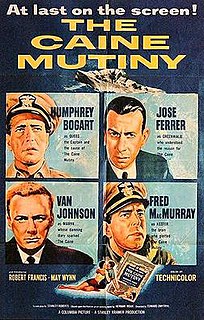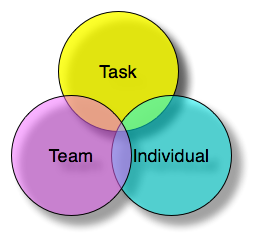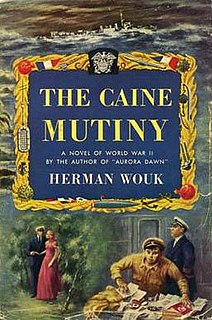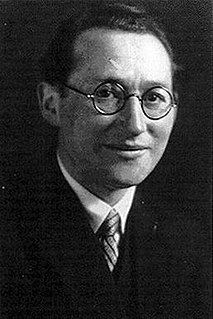Group psychotherapy or group therapy is a form of psychotherapy in which one or more therapists treat a small group of clients together as a group. The term can legitimately refer to any form of psychotherapy when delivered in a group format, including cognitive behavioural therapy or interpersonal therapy, but it is usually applied to psychodynamic group therapy where the group context and group process is explicitly utilised as a mechanism of change by developing, exploring and examining interpersonal relationships within the group.

The Caine Mutiny is a 1954 American film. A fictional Navy drama set in the Pacific during World War II, it was directed by Edward Dmytryk and produced by Stanley Kramer, and stars Humphrey Bogart, José Ferrer, Van Johnson, and Fred MacMurray. The film is based on The Caine Mutiny, the 1951 Pulitzer Prize-winning novel written by Herman Wouk. It depicts the events on board a fictitious World War II U.S. Navy minesweeper and a subsequent court-martial for mutiny.

An organization or organisation is an entity comprising multiple people, such as an institution or an association, that has a particular purpose.
Group dynamics is a system of behaviors and psychological processes occurring within a social group, or between social groups. The study of group dynamics can be useful in understanding decision-making behaviour, tracking the spread of diseases in society, creating effective therapy techniques, and following the emergence and popularity of new ideas and technologies. Group dynamics are at the core of understanding racism, sexism, and other forms of social prejudice and discrimination. These applications of the field are studied in psychology, sociology, anthropology, political science, epidemiology, education, social work, business, and communication studies.

In the social sciences, a social group can be defined as two or more people who interact with one another, share similar characteristics, and collectively have a sense of unity. Other theorists disagree however, and are wary of definitions which stress the importance of interdependence or objective similarity. Instead, researchers within the social identity tradition generally define it as "a group is defined in terms of those who identify themselves as members of the group". Regardless, social groups come in a myriad of sizes and varieties. For example, a society can be viewed as a large social group.
Organization development (OD) is the study of successful organizational change and performance. OD emerged from human relations studies in the 1930s, during which psychologists realized that organizational structures and processes influence worker behavior and motivation. More recently, work on OD has expanded to focus on aligning organizations with their rapidly changing and complex environments through organizational learning, knowledge management and transformation of organizational norms and values. Key concepts of OD theory include: organizational climate, organizational culture and organizational strategies.
The Zeitgeist is a concept from 18th- to 19th-century German philosophy, translated as "spirit of the age" or "spirit of the times". It refers to an invisible agent or force dominating the characteristics of a given epoch in world history.

Functional leadership theory is a theory for addressing specific leader behaviours expected to contribute to organizational or unit effectiveness. This theory argues that the leader's main job is to see that whatever is necessary to group needs is taken care of; thus, a leader can be said to have done their job well when they have contributed to group effectiveness and cohesion.
Cooperative learning is an educational approach which aims to organize classroom activities into academic and social learning experiences. There is much more to cooperative learning than merely arranging students into groups, and it has been described as "structuring positive interdependence." Students must work in groups to complete tasks collectively toward academic goals. Unlike individual learning, which can be competitive in nature, students learning cooperatively can capitalize on one another's resources and skills. Furthermore, the teacher's role changes from giving information to facilitating students' learning. Everyone succeeds when the group succeeds. Ross and Smyth (1995) describe successful cooperative learning tasks as intellectually demanding, creative, open-ended, and involve higher order thinking tasks. Cooperative learning has also been linked to increased levels of student satisfaction.
A T-group or training group is a form of group training where participants themselves learn about themselves through their interaction with each other. They use feedback, problem solving, and role play to gain insights into themselves, others, and groups.
A contingency theory is an organizational theory that claims that there is no best way to organize a corporation, to lead a company, or to make decisions. Instead, the optimal course of action is contingent (dependent) upon the internal and external situation. A contingent leader effectively applies their own style of leadership to the right situation.

The Caine Mutiny is the 1951 Pulitzer Prize–winning novel by Herman Wouk. The novel grew out of Wouk's personal experiences aboard a destroyer-minesweeper in the Pacific Theater in World War II. Among its themes, it deals with the moral and ethical decisions made at sea by ship captains. The mutiny of the title is legalistic, not violent, and takes place during Typhoon Cobra, in December 1944. The court-martial that results provides the dramatic climax to the plot.
Sensitivity training is a form of training with the goal of making people more aware of their own goals as well as their prejudices, and more sensitive to others and to the dynamics of group interaction.

The Caine Mutiny Court-Martial is a two-act play, of the courtroom drama type, that was dramatized for the stage by Herman Wouk, which he adapted from his own novel, The Caine Mutiny.
Situational Leadership Theory, or the Situational Leadership Model, is a model created by Paul Hersey and Ken Blanchard, developed while working on Management of Organizational Behavior. The theory was first introduced in 1969 as "life cycle theory of leadership". During the mid-1970s, life cycle theory of leadership was renamed "Situational Leadership Theory."
Trait leadership is defined as integrated patterns of personal characteristics that reflect a range of individual differences and foster consistent leader effectiveness across a variety of group and organizational situations. The theory of trait leadership is developed from early leadership research which focused primarily on finding a group of heritable attributes that differentiate leaders from nonleaders. Leader effectiveness refers to the amount of influence a leader has on individual or group performance, followers’ satisfaction, and overall effectiveness. Many scholars have argued that leadership is unique to only a select number of individuals and that these individuals possess certain immutable traits that cannot be developed. Although this perspective has been criticized immensely over the past century, scholars still continue to study the effects of personality traits on leader effectiveness. Research has demonstrated that successful leaders differ from other people and possess certain core personality traits that significantly contribute to their success. Understanding the importance of these core personality traits that predict leader effectiveness can help organizations with their leader selection, training, and development practices.
The task-relationship model is defined by Forsyth as "a descriptive model of leadership which maintains that most leadership behaviors can be classified as performance maintenance or relationship maintenances." Task-oriented leadership is a behavioral approach in which the leader focuses on the tasks that need to be performed in order to meet certain goals, or to achieve a certain performance standard. Relationship-oriented leadership is a behavioral approach in which the leader focuses on the satisfaction, motivation and the general well-being of the team members.
Implicit leadership theory (ILT) is a cognitive theory of leadership developed by Robert Lord and colleagues. It is based on the idea that individuals create cognitive representations of the world, and use these preconceived notions to interpret their surroundings and control their behaviors. ILT suggests that group members have implicit expectations and assumptions about the personal characteristics, traits, and qualities that are inherent in a leader. These assumptions, termed implicit leadership theories or leader prototypes, guide an individual's perceptions and responses to leaders. The term implicit is used because they are not outwardly stated and the term theory is used because it involves the generalization of past experiences to new experiences. ILTs allow individuals to identify leaders and aid them in responding appropriately to leaders in order to avoid conflict.







